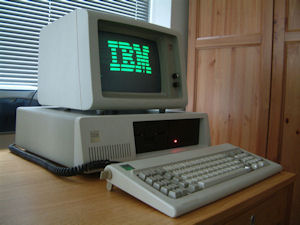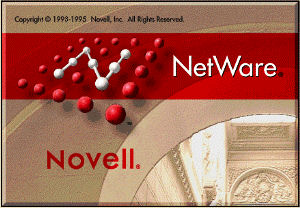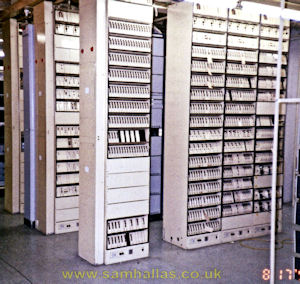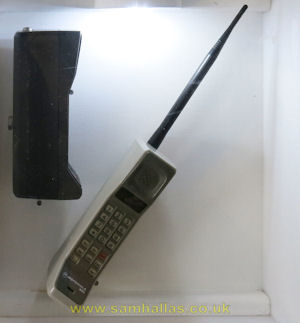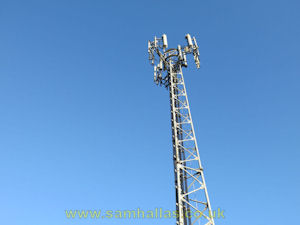Bringing up to date
Looking back at the state of digital technology in 1987, it seems that there have been more changes in the last twenty-seven years than in the preceding hundred and fifty. If we take a broad definition of telegraphy to be communication of the written word, images or information, there is still a vast array of changes.
We're all digital now
Computers and Networking
Back in 1987 our desks had computers in grey boxes with cathode ray tube monitors, only a little advanced from the first IBM personal computer. Hards disks were only a few megabytes in size and memory was so expensive that thieves used to break into offices to steal the chips from computers. [Picture: Ruben de Rijcke - creative commons]
Networking within our office used a Novell Netware file server and coaxial cable to the workstations. Connection between offices used what were optimistically called 'high-speed' modems over analogue telephone circuits. 2400 bits per second counted as high-speed in 1987.
Also speaking at the RSGB Data Symposium in 1987 was a group of amateur experimenters using something called TCP/IP (Transmission Control Protocol/Internet Protocol) - at the time a meaningless string of letters to most of us. In time this led to the start of AMPRNet (AMateur Packet Radio Network) which, although never mainstream in amateur radio circles, was still in existence in 2014.
Over the next decade TCP/IP escaped from the confines of the military and academia into mainstream commercial networks. With the invention of HTML (HyperText Mark-up Language) by Tim Berners-Lee the seeds of the modern Internet were sown.
As a result, this page of text you are reading and its pictures were created in HTML and are brought to you via the medium of TCP/IP.
Telephony
In 1987 some telephone traffic was already being carried digitally over 32 channels in a stream of 2048 kBit/s. Streams were multiplexed into groups forming a Plesiochronous Digital Hierarchy (PDH) over coaxial trunk cables.
Rapid advances in the technology of optical fibre and international standardisation led to the Synchronous Digital Hierarchy in use to the present day. This allows a mixture of traffic to be carried on the one network: telephony, internet, video, other data.
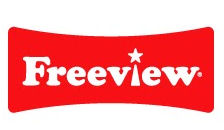
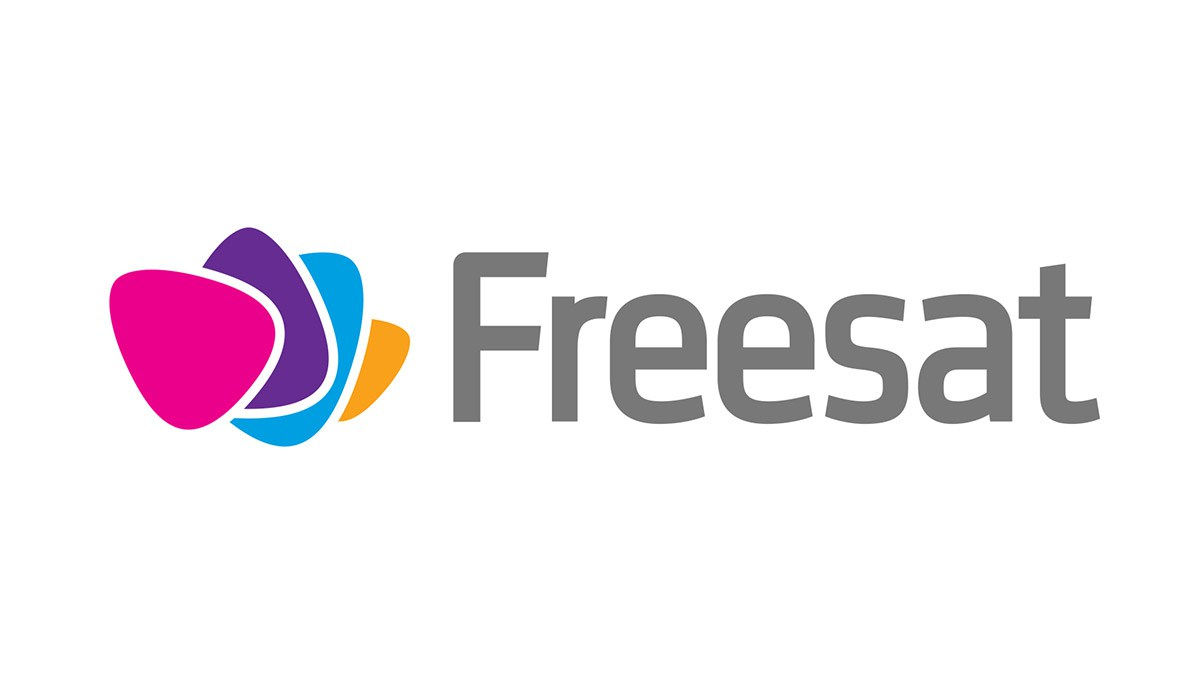
Television
In 1998 even the television services in the UK went digital. Terrestrial transmissions on the UHF frequencies were under the brand name of Freeview. Satellite services provided by BSkyB were transmitted from the Astra 2A and Eutelsat 28A satellites at 28.2° & 28.5° East in the Ku Band (10.7 to 12.75 GHz).
The analogue terrestrial television transmissions in the UK were gradually phased out and the last area to be served was Northern Ireland which closed in 2012.
Radio

Needless to say, radio broadcasting was not far behind its television cousin. Digital Audio Broadcasts (DAB) could be received by 1999 in Band III (174-240 MHz). Wikipedia quotes the UK as having the world's biggest digital radio network (in 2013).
Proposals had been made by the government to switch off the analogue radio broadcasts in Band II (88-104 MHz), partly for greed to sell off the frequencies and partly under pressure from major broadcasters wanting to rationalise their networks. However, the government back pedalled on their plans in 2013 after representation from local independent stations and millions of users of car radios. No date had been set for any switch.
Mobile Radio
In 1987 the UK was still using analogue mobile phones like the 'talking brick' from Motorola illusrated. I recall borrowing one from work allowing me to swan around looking important.
It took until the 1990s for international agreement on the standard for digital mobiles, first called Groupe Spéciale Mobile and later Global System for Mobile communications. Services in the UK took off from 1992. At first GSM used the 900 MHz band but within two years had been expanded to the 1800 MHz band. More on the history of GSM in this University of Salford article.
The Short Message Service (SMS) for text was something of an afterthought to the GSM specification. Early phones didn't have any means of sending text messages so the first reported message was sent from a computer to a mobile phone in 1992. However once users got capable phones and realised the potential of SMS, its growth was more or less exponential. By 2013 it was estimated that 7,600 billion messages were sent worldwide if the graph on this site is to be believed. Mobile operators suggest that SMS usage has now stagnated and may decline as other forms of messaging via social media take hold.
So where's Telegraphy now?
Of the systems and services shown in the first three pages of this article, many have become obsolete and have either closed, are only used by a few enthusiasts, or form niche markets. Systems such as:
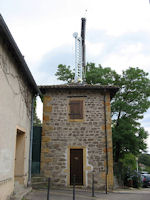
- Altough they fell out of use after the French revolution, some of the original sites on the Chappe military telegraph line in France have been restored to working order. Here's one at Sainte-Foy-lès-Lyon
- Morse code by radio is no longer used by shipping, but still has its place in amateur radio.
There is no cable Morse any more, but some enthusiasts are sending it over the internet - such as the Morse Telegraph Club - Teleprinters and Telex are no longer in use in the UK, but vestiges of the telex service remain in certain parts of the Third World. The teleprinter code is still used by amateur radio groups, but is mostly sent and received on computers. The British Amateur Radio Teledata Group is one such organisation keeping the tradition alive. A small group in Europe have set up a network of teleprinters using the Internet to simulate to original Telex network, called i-Telex
- FAX Machine usage seems to be dying out in many parts of the world, but places with logographic languages, such as China and Japan, are still major users of FAX. In addition, many computer printers at the budget end of the market boast three-in-one capabilities: printing, scanning and FAXing, though it is doubtful if many of them get used for transmitting documents.
- Pocket pagers declined after the mid 1990s, but, according to Wikipedia, still find a niche market "in applications such as hospitals, public safety, and retail locations where their simplicity, high reliability, and low cost represent significant advantages."
Sticking with my earlier definition of telegraphy as conveying the written word, images or information I offer the following suggestions as to where telegraphy is to be found in mainstream communications.
- Morse code, teleprinters and FAX have been replaced by email via the internet and the world-wide web.
- Wireless telegraphy has been replaced by the short messaging system on mobile telephones, or by the internet as before using WiFi or 3G & 4G mobile technology.
- However, wireless telemetry seems to be still alive and well to judge from the number of aerials visible at pumping stations, sewage plants etc. It's also widely used by animal welfare and conservation organisations for tracking many forms of wildlife, such as migrating birds. Mobile machinery, such as an aircraft engine, is able to report its status back to the manufacturers or service department.
- The widely promised 'Internet of Things' will, in the future, connect more and more hardware together allowing, say, my fridge to re-order from the supermarket the food that I've consumed, or my mobile phone to warn the home central heating to turn on when I'm within a certain distance of home.
So that's it for the present
The Victorians started to connect the earth with their telegraph cables in the mid 19th century. Since then we've continued to add connections, by wireless, by coaxial cables, fibre optics, and satellites, so that by 2017 as I write there is virtually nowhere on earth that cannot make some sort of connection.
References:
|
Exhibits used as illustration were photographed in the following collections:
|
These articles copyright 1987-2017, AG Hobbs & SM Hallas.
Back to TopPart 1
Part 2
Part 3
Telecomms Index

